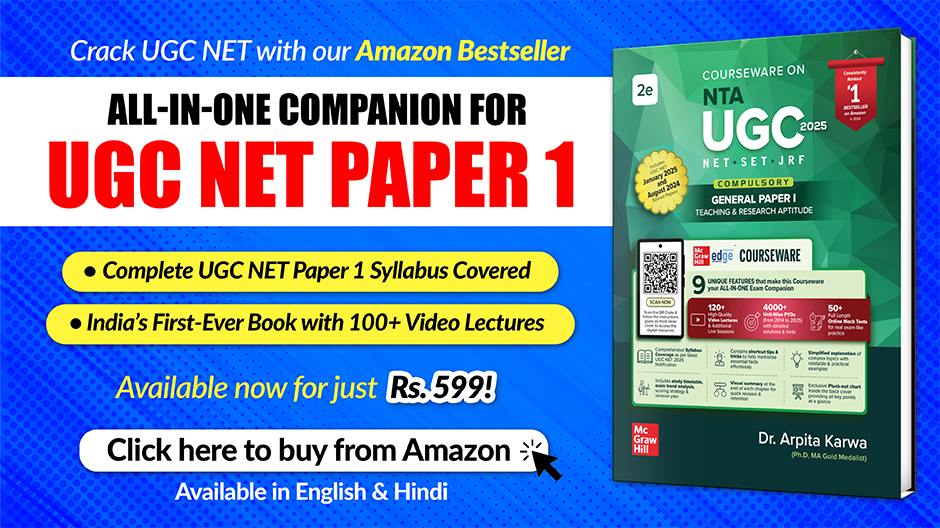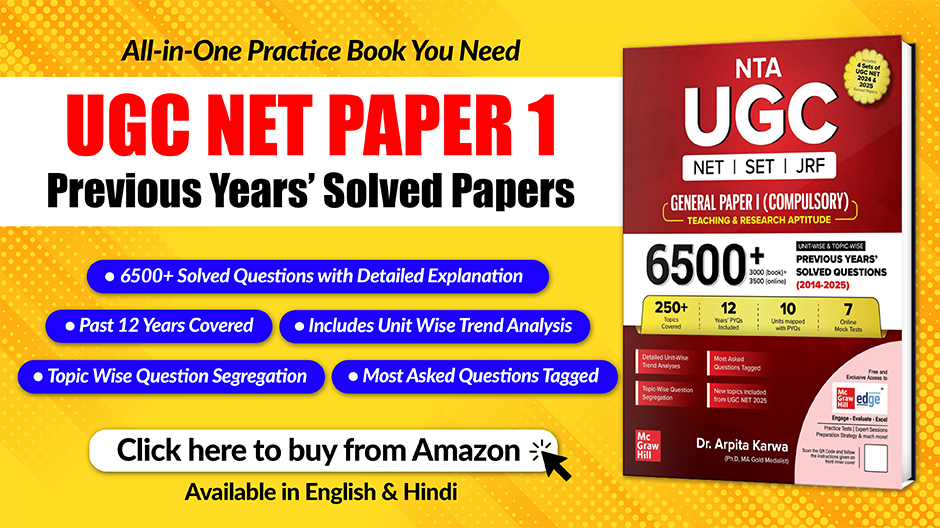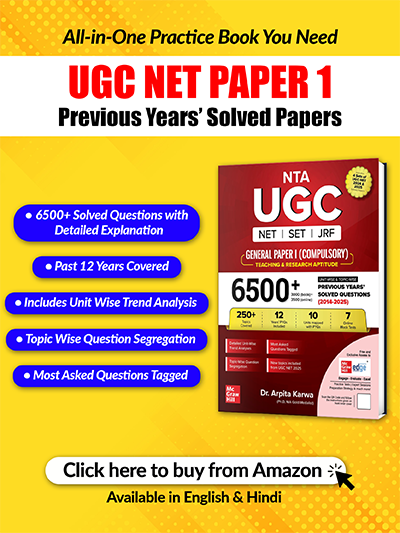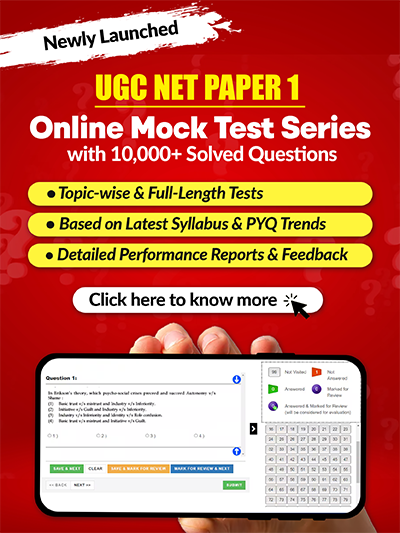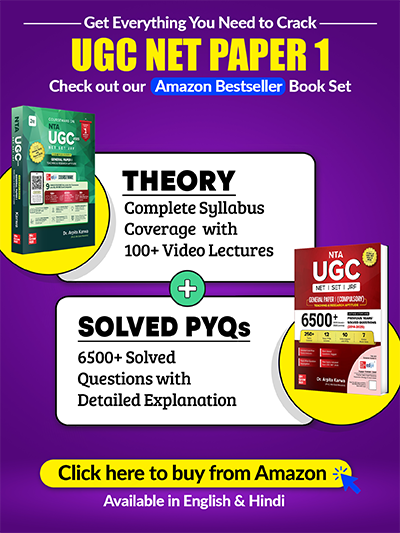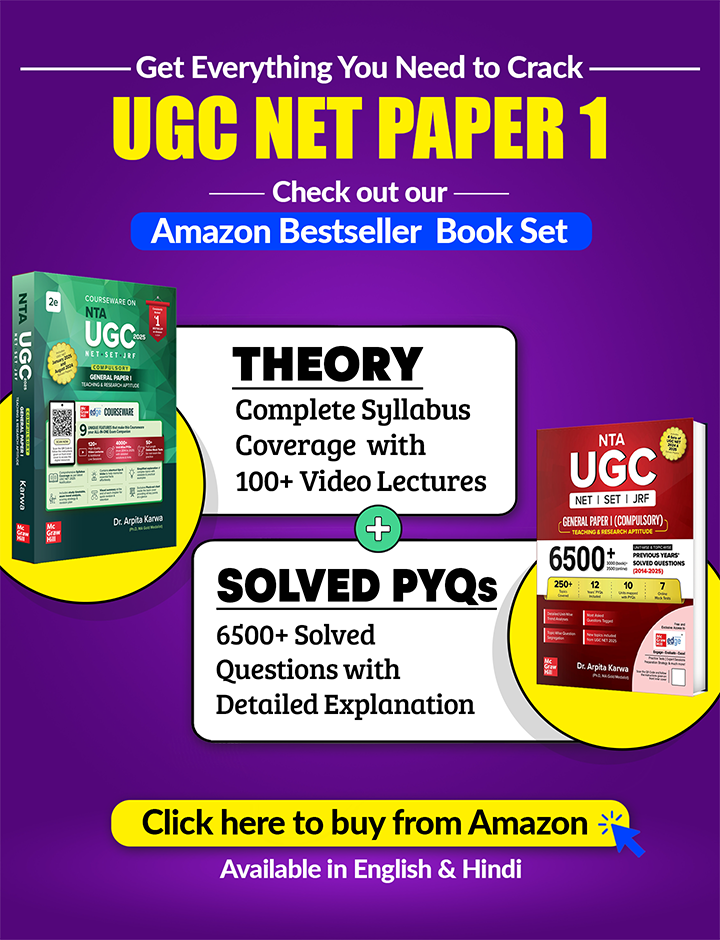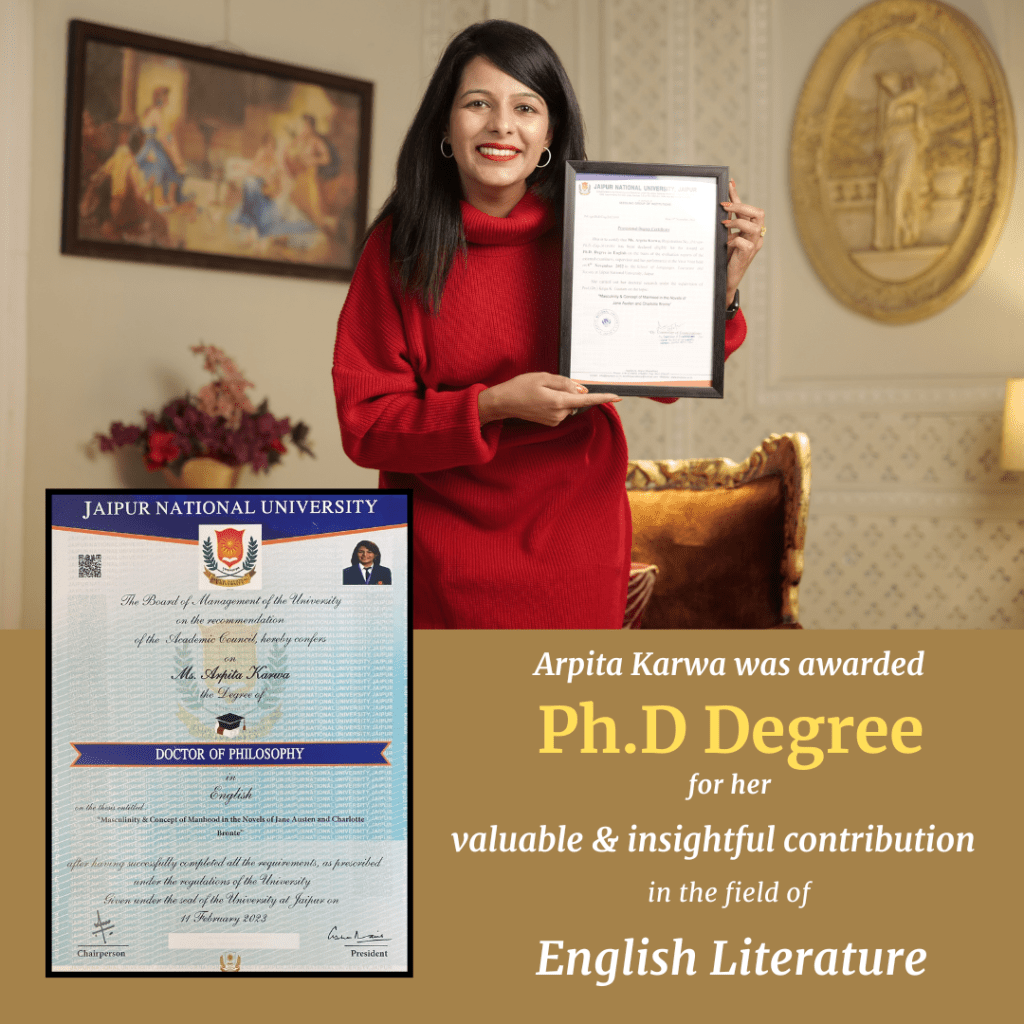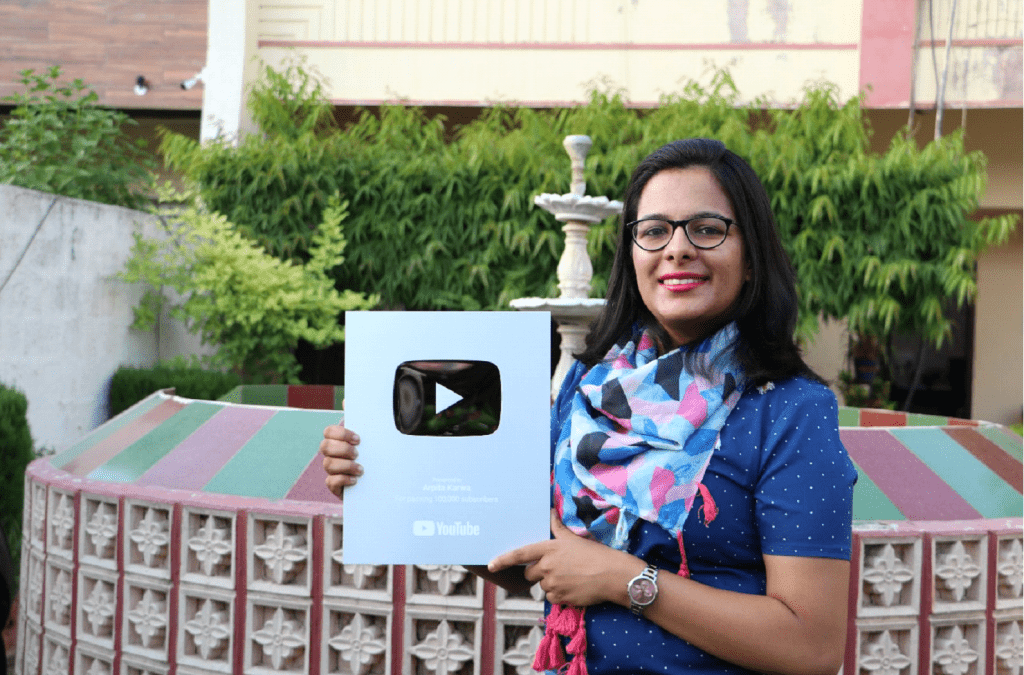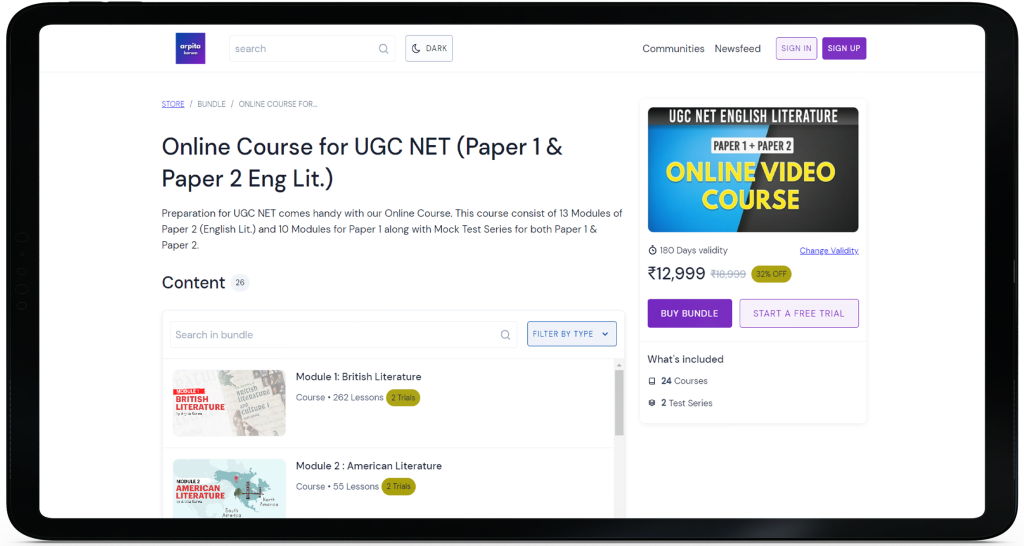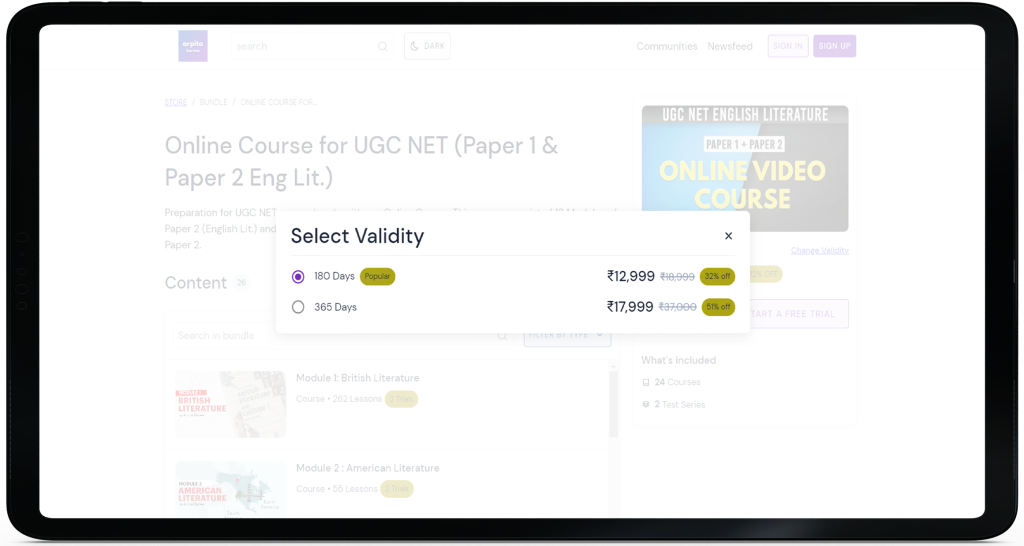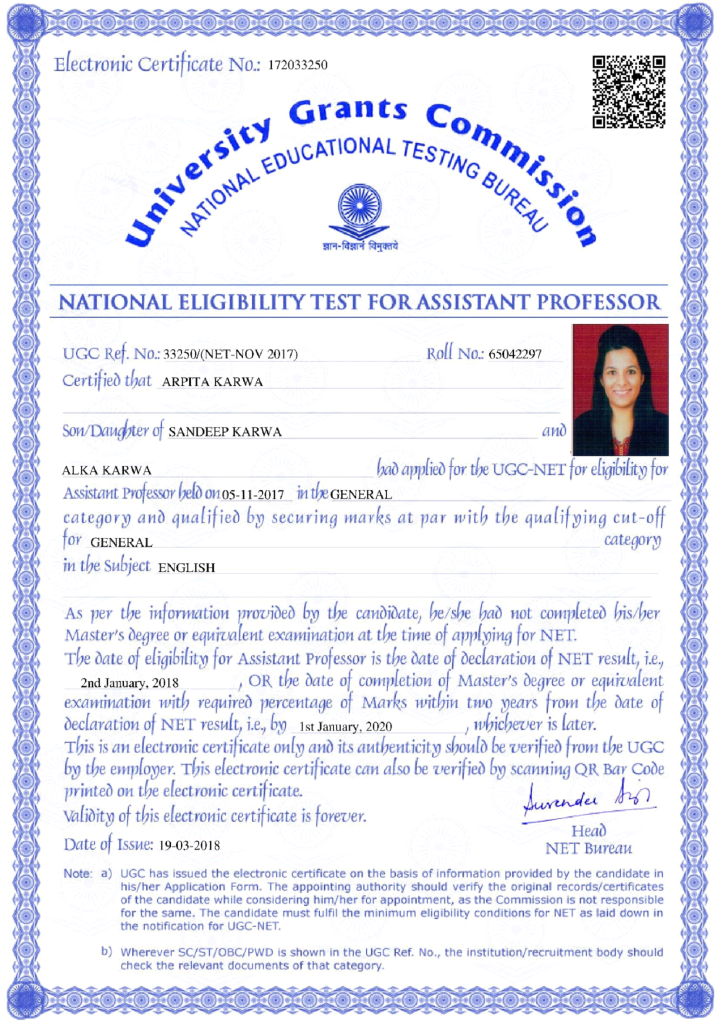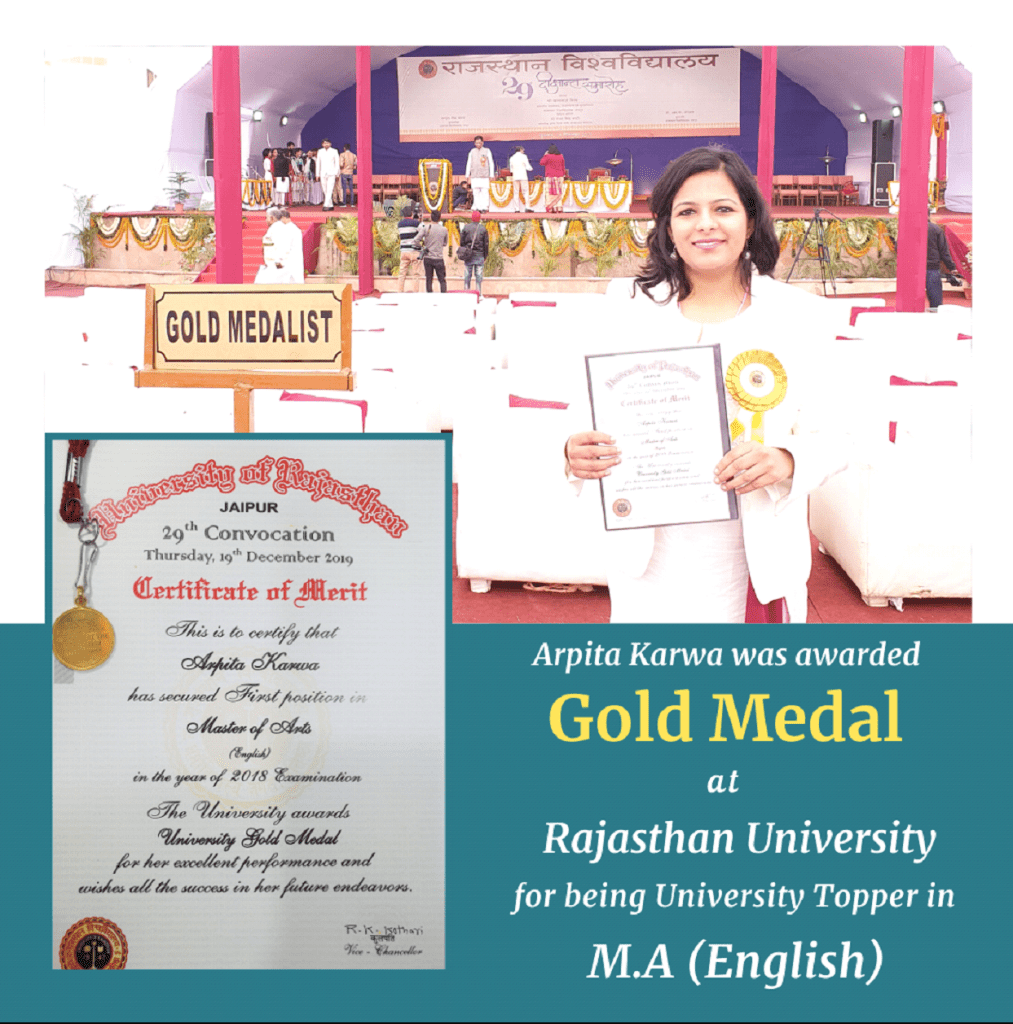June 2025 : Paper 2 (Conducted on 27th June 2025 : Evening Shift)
June 19, 2024 2025-10-13 15:00June 2025 : Paper 2 (Conducted on 27th June 2025 : Evening Shift)
June 2025 : Paper 2 (Conducted on 27th June 2025 : Evening Shift)
Q.1) Arrange the following works chronologically:
A. The Heart of Hindustan
B. Occasional Speeches and Writings
C. Eastern Religions and Western Thought
D. Dhammapada
E. The Principal Upanishads
Choose the correct answer from the options given below:
[1] D,C,A,B,E
[2] C,AEBD
[3] B,C.,D,E A
[4] A,C,DEB
Answer: 4
Q.2) Match the column:
(Author)
A. Lois Reynolds Kerr
B. Dorothy Livesay
C. Gwen Pharis Ringwood
D. Carol Bolt
(Work)
I. Dark Harvest
Il. Guest of Honour
III. Red Emma
IV. Joe Derry
[1] A-ll, B-IV, C-l, D-lII
[2] A, B-ll, C-lIl, D-IV
[3] A-lll, B-l, C-IV, D-lI
[4] A-lV, B-lI, C-llI, D-I
Answer: 1
Q.3) The term “Trace”, which refers to the trace of the other, has been borrowed by Jacques Lacan from:
[1] Jacques Derrida
[2] Immanuel Levinas
[3] Sigmund Freud
[4] Christopher Norris
Answer: 2
Q.4) Who made the following remark?
“The Sanskrit language, whatever be its antiquity, is of a wonderful structure; more perfect than the Greek, more copious than the Latin, and more exquisitely refined than either, yet bearing to both of them a stronger affinity, both in the roots of verbs and in the forms of grammar, than could possibly have been produced by accident.”
[1] Sir William Jones
[2] Patsy M Lightbown
[3] Ferdinand de Saussure
[4] Albert Sydney Hornby
Answer: 1
Q.5) Arrange the following novels in a chronological order as per their years of publication:
A. The Serpent and the Rope
B. Two Leaves and a Bud
C. A Bend in the Ganges
D. So Many Hungers
E. Waiting for the Mahatma
[1] AEBDC
[2] BACED
[3] CDBEA
[4] BDEAC
Answer: 4
Q.6) Arrange the following works of Criticism chronologically:
A. More than Cool Reason
B. Death is the Mother of Beauty
C. Margins of Discourse
D. Meter in English: A Critical Engagement
E. The Rule of Metaphor
[1] BDCAE
[2] CAEDB
[3] EDACB
[4] EACBD
Answer: 4
Q.7) Match the column:
(Lines)
A. One day I wrote her name upon the strand/ But came the waves and washed it away
B. Under the greenwood tree/ Who loves to lie with me,/ And turn his merry note/ Unto the sweet bird’s note
C. The curfew tolls the knell of parting day,/ The lowing herd wind slowly o’er the lea
D. Remember how we picked the daffodils?/ Nobody else remembers, but I remember.
(Author)
I. Thomas Gray
II. William Shakespeare
III. Ted Hughes
IV. Edmund Spenser
[1] A-II B-IV C-I D-III
[2] A-IV B-II C-I D-III
[3] A-III B-I C-IV D-II
[4] A-IV B-III C-II D-I
Answer: 2
Q.8) Match the column:
A. Cynthia’s Revels
B. The Maid’s Tragedy
C. Women Beware Women
D. The Shoemakers’ Holiday
I. Thomas Middleton
II. Ben Jonson
III. Thomas Dekker
IV. Beaumont and Fletcher
[1] A-II, B-IV, C-I, D-III
[2] A-IV, B-II, C-I, D-l
[3] A-III, B-I, C-IV, D-II
[4] A-lV, B-Il, C-lI, D-I
Answer: 1
Q.9) Which of the following is not a kind of literary research?
[1] Bibliography and textual criticism
[2] Biographical
[3] Experimental Research
[4] Interpretive
Answer: 3
Q.10) Read the following statements carefully and choose the correct ones:
A. Patrick White, Christina Stead and Robertson Davies are the famous Australian novelists.
B. The notion of “civilized barbarity” was anticipated in H. Rider Haggard’s 1887 novel Allan Quatermain, in which “Civilization” is said to be “only savagery silver-gilt”.
C. Novels like French Lieutenant’s Woman, Midnight’s Children and Waterland deconstruct traditional notions of history and subjectivity.
D. O’Brian’s Country Girls trilogy and McGahern’s The Dark which were banned in Ireland were published during 1950s.
E. The trauma of the mid-century years accounts for the prevalence of dystopian elements in novels like A Clockwork Orange, Lanark and The Handmaid’s Tale.
[1] ACD
[2] ABD
[3] BCE
[4] BCD
Answer: 3
Q.11) Erziehungsroman is a term which signifies:
[1] French Term signifies ‘Novel of Manners’
[2] Greek Term signifies ‘Novel of Love’
[3] Roman Term signifies ‘Novel of Sentiments’
[4] German Term signifies ‘Novel of Education’
Answer: 4
Q.12) Choose the correct statements regarding scope of linguistics from the following:
A. To describe and trace the history of all observable languages.
B. To determine the forces that are permanently and universally at work in all languages.
C. To study manifestations of civilized human speech only.
D. To consider only correct speech and flowery language.
E. To delimit and define itself.
[1] ABE
[2] BCD
[3] BDE
[4] ACD
Answer: 1
Q.13) Lord Curzon used the report of Indian Universities Commission of 1902 to:
[1] decentralize school education.
[2] give representation to Indians in policy making.
[3] withdraw Indian Universities Act of 1904.
[4] centralize school education under a Director-General of Education.
Answer: 4
Q.14) The term “Chronotope” has been coined by-
[1] Mikhail Bakhtin
[2] Stephen Greenblatt
[3] Bertolt Brecht
[4] JH Miller
Answer: 1
Q.15) Arrange the following stages of first language acquisition schedule in its’ chronological order:
A. The Two-Word Stage
B. Telegraphic Speech
C. The One-Word Stage
D. Cooing
E. Babbling
[1] BCAED
[2] CABED
[3] CADEB
[4] DECAB
Answer: 4
Q.16) Choose the statements given by Virginia Woolf about women:
A. “She is born stupid and can do nothing but stupidity.”
B. “She dominates the lives of kings and conquerors in fiction.”
C. “She pervades poetry from cover to cover; she is all but absent from history.”
D. She criticized Shakespeare for being harsh and rude to his female characters in his plays.
E. “(I)n real life she could hardly read, could scarcely spell, and was the property of her husband”.
[1] ABE
[2] BCE
[3] ADE
[4] ABC
Answer: 2
Q.17) Arrange the following books in chronological order:
A. G. N. Shuster’s The English Ode from Milton to Keats
B. Paul H. Fry’s The Poet’s Calling in the English Ode
C. John Heath-Stubbs’ The Ode
D. Carol Maddison’s Apollo and the Nine: A History of the Ode
E. G.M. Foley’s Oral Traditional Literature
[1] CADEB
[2] ABCED
[3] ADCBE
[4] EBCDA
Answer: 3
Q.18) Choose the correct statements.
A. English literature was first offered as a subject of study at King’s College, London in 1831.
B. English was first offered as a subject of study in England only in 1828 in the universities of Oxford and Cambridge.
C. Though taught as a medium of instruction and a subject of study in India since 1850s, Oxford and Cambridge did not allow the new subject of English literature to be taught till the end of the nineteenth century.
D. In 1931, English replaced the study of classics in Greek and Latin (the language of the Church) in Oxford and Cambridge.
E. Till the end of the nineteenth century literature meant only the study of great books in classical languages like Greek and Latin in Oxford and Cambridge.
[1] ACE
[2] BCD
[3] ABC
[4] BDE
Answer: 1
Q.19) Arrange the following steps of material collection according to hierarchy given by Delia da Sousa Correa and W.R. Owens in The Handbook to Literary Research:
A. Identify your nearest major research library
B. Visit your own university library
C. Identify what is available online
D. Visit your nearest major research library
[1] DACB
[2] ABCD
[3] BADC
*[4] CBAD
Answer: 4
Q.20) Which of the following statements have been given by Barbara Johnson:
A. “Deconstruction is not synonymous with destruction…”
B. “The deconstruction of a text does not proceed by random doubt or arbitrary subversion…”
C. “Deconstruction is not a dismantling of the structure of a text but a demonstration that it has already dismantled itself.”
D. “If anything is destroyed in a deconstructive reading, it is not the text, but the claim to unequivocal domination of one mode of signifying over another.”
E: “Deconstruction as a mode of interpretation works by a careful and circumspect entering of each textual labyrinth…”
[1] ABD
[2] ACE
[3] BCD
[4] ADE
Answer: 1
Q.21) Match the column:
A. John Gross
B. Wendy Martin
C. George Saintsbury
D. Richard A Lanham
I. A History of English Prose Rhythm
II. The Oxford Book of Essays
III. Essays by Contemporary American Women
IV. Analyzing Prose
[1] AII B-II C-I D-IV
[2] A-I B-II C-III D-IV
[3] A-IV B-III C-I D-II
[4] A-IV B-II C-I D-III
Answer: 1
Q.22) Arrange the following core elements of list of Work Cited according to MLA Handbook 9th edition:
A. Publisher
B. Title of Source
C. Author
D. Title of Container
E. Publication Date
[1] CBDAE
[2] CDBEA
[3] CBEAD
[4] CBDEA
Answer: 1
Q.23) Choose the correct statements amongst the following:
A. Macaulay was the practical man of affairs, helping and rejoicing in the progress of his beloved country.
B. Ruskin was like a Hebrew prophet just in from the desert, and the burden of his message was, “Woe to them that are at ease in Zion!”
C. Arnold was much like the cultivated Greek; his voice was soft, his speech suave, but he left the impression that you must be deficient in culture.
D. Newman was like the best French prose writers in expressing his thought with such naturalness and apparent ease that, without thinking of style, we received exactly the impression which he meant to convey.
[1] ABC
[2] ACD
[3] BCE
[4] CDE
Answer: 2
Q.24) Who prepared the first blueprint on English education in India in 1792?
[1] William Carey
[2] Charles Grant
[3] Lord Minto
[4] William Pitt
Answer: 2
Q.25) The study of how human beings acquire language and how we use language to speak and understand is called:
[1] Theoretical Linguistics
[2] Sociolinguistics
[3] Applied Linguistics
[4] Psycholinguistics
Answer: 4
Q.26) Who has described his criticism as a “by-product” of his “private poetry-workshop” and as “a prolongation of the thinking that went into the formation of my own verse”?
[1] S.T. Coleridge
[2] Matthew Arnold
[3] Ezra Pound
[4] T.S. Eliot
Answer: 4
Q.27) Match the column:
A. Thick description
B. Transcendental signified
C. Vehicle, Tenor
D. Alienation Effect
I. Jacques Derrida
II. A Richards
III. Bertolt Brecht
IV. Clifford Geertz
[1] A-lV, B-I, C-II, D-III
[2] A-l, B-III, C-lI, D-IV
[3] A-II, B-I, C-III, D-IV
[4] A-III, B-II, C-I, D-IV
Answer: 1
Q.28) Match the column:
A. He turned his back on the ‘two decades of hypocrisy’.
B. The Welsh traditions of the power of spoken word are present in his poetry.
C. He is identified as a representative middle-brow voice of the present, adjusting to the past.
D. His poetry plays with and against Romantic tradition in poetry.
I. Dylan Thomas
II. John Betjeman
III. Philip Larkin
IV. W. H. Auden
[1] A-I, B-II, C-II, D-IV
[2] A-II, B-IV, C-I, D-III
[3] A-lV, B-l, C-II, D-III
[4] A-III, B-I, C-IV, D-II
Answer: 3
Q.29) Arrange the following commissions, committees, and events, which were important in the context of the history of English in India, in chronology:
A. Gokak Committee Report
B. Acharya Ramamurti Commission
C. All India Language Conference
D. Kothari Commission
E. The Official Language Act
[1] BEDCA
[2] CEDAB
[3] ABDCE
[4] DECBA
Answer: 2
Q.30) Choose the correct definitions of language:
A. Language uses symbols that are primarily vocal but may also be visual and its’ subfields are phonetics, phonology, writing systems, orthography, and nonverbal communication.
B. Language is used for communication and its’ subfields are sentence processing, pragmatics, discourse analysis, and conversation analysis.
C. Language uses symbols that have unconventionalized meanings and its’ subfields are universal grammar, innateness, emergentism, neurolinguistics and cross-cultural analysis.
D. Language is a systematic means of communicating ideas or feelings by the use of conventionalized signs, sounds, gestures, or marks having understood meanings.
E. Language has region specific characteristics and its’ subfields are phonetics, phonology, morphology, syntax, discourse analysis, and lexical analysis.
[1] ABC
[2] ABD
[3] BCD
[4] BDE
Answer: 2
Q.31) Which of the following critics are associated with Frankfurt School of German Intellectuals:
A. Walter Benjamin
B. Luara Mulvey
C. Travis Henderson
D. Max Horkheimer
E. Leo Lowenthal
[1] ADE
[2] CDE
[3] BCD
[4] ACE
Answer: 1
Q.32) Match the column:
(Term)
A. et sq.
B. idem
C. loc. cit.
D. passim
(Meaning)
I. the same
II. in the place cited
III. everywhere
IV. and the following
[1] A-III, B-II, C-I, D-IV
[2] A-II, B-III, C-IV, D-I
[3] A-lV, B-I, C-II, D-III
[4] A-I, B-IV, C-III, D-II
Answer: 3
Q.33) Choose the correct key points related to approach to Feminism and Gender Studies:
A. Feminism is concerned with the marginalization of women in a patriarchal culture.
B. Feminist critics explain how the subordination of women is reflected or challenged by literary texts. They examine the experiences of women of all races, classes, sexual preferences, and cultures.
C. Mary Wollstonecraft defines four models of sexual difference: biological, linguistic, psychoanalytic, and cultural.
D. Feminist critics’ goals: to expose patriarchal premises and resulting prejudices, to promote the discovery and reevaluation of literature by women, and to examine social, cultural, and psychosexual contexts of literature and literary criticism.
E. Simone de Beauvoir prefers “womanism” to “feminism.”
[1] ABC
[2] ABD
[3] BCD
[4] BDE
Answer: 2
Q.34) Which of the following is not a distinct discourse analytical research tradition as suggested by Margaret Wetherall et al.?
[1] Discursive psychology
[2] Bakhtinian research
[3] Saussurian research
[4] Foucauldian research
Answer: 3
Q.35) Choose the correct match of play and playwright.
A. Hali — Rabindranath Tagore
B. Tiger Claw — Lakhan Deb
C. The Flute of Krishna — P A Krishnaswami
D. Nalini — Gurucharan Das
E. Hayavadana – Girish Karnard
[1] BCE
[2] ADE
[3] ACD
[4] BCD
Answer: 1
Q.36) Match the column:
A. Collocation
B. Inflected
C. Polarity
D. Generative
I. A term borrowed in the 1960s from mathematics into linguistics by Noam Chomsky
II. A term for the contrast between positive and negative in sentences, clauses, and phrases
III. A habitual association between particular words
IV. A term in which a word takes various forms to show its grammatical role
[1] A-I, B-II, C-III, D-IV
[2] A-III B-IV, C-lI, D-I
[3] A-I, B-III, C-IV, D-Il
[4] A-lV, B-I, C-II, D-III
Answer: 2
Q.37) Match the column:
(Work)
A. Poverty and Un-British Rule in India
B. The Slave Girl of Agra
G Love Songs and Elegies
D. Gora
(Author)
I. Romesh Chander Dutt
II. Dadabhai Naoroji
III. Rabindranath Tagore
IV. Manmohan Ghosh
[1] A-II, B-I, C-IV, D-III
[2] A-I, B-II, C-III, D-IV
[3] A-III, B-I, C-IV, D-II
[4] A-IV, B-II, C-III, D-I
Answer: 1
Q.38) Match the column:
A. Pidgin
B. Creole
C. Idiolect
D. Register
I. The language special to an individual, sometimes described as a ‘personal dialect’.
II. A language defined according to social use, such as scientific, formal, religious, and journalistic.
III. A contact language which draws on elements from two or more languages
IV. A term relating to people and languages especially in the erstwhile colonial tropics and subtropics, in the Americas, Africa, the Indian Ocean, and Oceania.
[1] A-I B-IV C-III D-II
[2] A-II B-III C-I D-IV
[3] A-IV B-II C-III D-I
[4] A-III B-IV C-I D-II
Answer: 4
Q.39) Who among the following is considered as “the father of South African English poetry”?
[1] Rider Hoggard
[2] Thomas Pringle
[3] John Buchan
[4] Percy Fitzpatrick
Answer: 2
Q.40) Kipling’s story “Mrs Bathurst” is set in
[1] India
[2] South Africa
[3] Canada
[4] Australia
Answer: 2
Q.41) The term “Remainder” has been first used by-
[1] Giorgio Agamben
[2] Guy Debord
[3] Jacques Derrida
[4] J. Habermas
Answer: 3
Q.42) Choose the correct statements.
A. Miller’s play The Crucible was first written in verse.
B. The American Dream is a play by Edward Albee about the absurd situation and immediate realities.
C. The American Dream is a novel by lonesco about the problems of a middle aged professional.
D. Miller’s play The Price is set in a baroque palace in eastern Europe teasing social and metaphysical sophistication that debates not only the responsibility of the writer but the extent to which reality is composed of a series of performed gestures.
E. Miller’s play The Price explores the extent to which we retrospectively invent our own history.
[1] ACD
[2] BDE
[3] BCD
[4] ABE
Answer: 4
Q.43) Since the publication of Samuel Johnson’s “Preface to Shakespeare” in 1765, which of the Unities have been regarded as optional devices, available as needed by playwrights in England to achieve special effects of dramatic concentration?
[1] Unities of Time and Action
[2] Unities of Place and Action
[3] Unities of Place and Time
[4] Unity of Place only
Answer: 3
Q.44) Identify the correct chronological order as per the publication years of the following works:
A. Characteristics of Men, Manners, Opinions and Times
B. The Advancement of Learning
C. Inquiry into the Original of our Idea of Beauty and Virtues
D. The Plan of a Dictionary of the English Language
[1] ACDB
[2] CADB
[3] DBAC
[4] BACD
Answer: 4
Q.45) Which of the following works is written by Joseph Conrad?
[1] Tales of Unrest
[2] The Madonna of the Future and other Tales
[3] The Two Magics
[4] The Spoils of Poynton
Answer: 1
Q.46) Identify the subtitle of Oliver Goldsmith’s semi-autobiographical poem, “The Traveller:
[1] A Prospect of Society
[2] The Citizen of the World
[3] The Fashionable Lover
[4] An Ancient Epic Poem
Answer: 1
Q.47) Which of the following rules are correct regarding formatting of date and time in the body of thesis writing according to MLA Handbook 9th Edition?
A. When using the month-day-year style in prose, a comma must be placed after the year unless another punctuation mark follows it.
B. Use a comma between month and year or between season and year.
C. Decades can be written out or expressed in numerals.
D. Spell out centuries in uppercase letters. & Numerals are used for most times of the day. Generally, use the twelve hour-clock system in prose
[1] ABC
[2] BCD
[3] ACE
[4] CDE
Answer: 3
Q.48) In how many volumes George Eliot’s Middlemarch was first published?
[1] Five separate volumes
[2] Eight separate volumes
[3] Seven separate volumes
[4] Ten separate volumes
Answer: 2
Q.49) Arrange the following works of Feminism in chronological order:
A. The Female Imagination
B. The Madwoman in the Attic
C. A Literature of their Own
D. Women’s Oppression Today: Problems in Marxist Feminist Analysis
E. Revolution in Poetic Language
[1] EDBCA
[2] BACED
[3] EACBD
[4] ABCDE
Answer: 3
Q.50) Which of the Schools of Criticism has strongly opposed Formalism, in both its European and American Varieties, rejecting the view that there is a sharp and definable division between ordinary language and literary language:
A. Marxism
B. Reader Response Criticism
C. Speech —Act Theory
D. New Historicism
E. Postcolonialism
[1] ABE
[2] ACE
[3] BCD
[4] ADE
Answer: 3
Q.51) Who wrote to the Committee of Public Instruction on introducing English as official language of the Government and that of education?
[1] Robert Clive
[2] Warren Hastings
[3] William Bentinck
[4] Zachary Macaulay
Answer: 3
Q.52) Name the theory which assumes that “culture is not separate from nature, and that there is no hierarchy of actants such that the human is more privileged”.
[1] Actor Network Theory
[2] Posthumanism
[3] Cultural Materialism
[4] Adaptation Theory
Answer: 1
Q.53) Match the column:
(Novel)
A. Silas Marner
B. Sybil
G Frankenstein
D. Oliver Twist
(Subtitle)
I. The Modern Prometheus
II. The Parish Boy’s Progress
III. The Two Nations
IV. The Weaver of Raveloe
[1] A-II, B-I, C-IV, D-III
[2] A-I, B-IV, C-II, D-III
[3] A-III, B-II, C-IV, D-I
[4] A-IV, B-III, C-l, D-II
Answer: 4
Q.54) Who has coined the phrase “Bricolage”?
[1] Claude Levi Strauss
[2] Raymond Williams
[3] Martin Heidegger
[4] Michel Foucault
Answer: 1
Q.55) Match the column:
A. “Liberty of the Press”
B. “The Vision of Mirza: An Oriental Allegory”
C. “On the Knocking at the Gate in Macbeth”
D. “Mental Slavery of Modern Workmen”
I. Thomas de Quincey
II. John Ruskin
III. John Milton
IV. Joseph Addison
[1] A-II, B-III, C-IV, D-I
[2] A-III, B-I, C-lI, D-IV
[3] A-IV, B-II, C-III, D-I
[4] A-III, B-IV, C-I, D-II
Answer: 4
Q.56) Jacques Derrida’s “Archive Fever: A Freudian Impression” is related to
[1] Archival Method
[2] Biographical Method
[3] Visual Method
[4] Creative Method
Answer: 1
Q.57) Who among the following Mughal rulers carried out an experiment for newborn babies to be raised in silence, only to find that the children produced no speech at all?
[1] Akbar
[2] Bahadur Shah Zafar
[3] Aurangzeb
[4] Babur
Answer: 1
Q.58) Arrange the following works of Criticism chronologically:
A. Gender Trouble: Feminism and the Subversion of Identity
B. A History of Gay Literature: The Male Tradition
C. History of Sexuality
D. New Lesbian Criticism: Literary and Cultural Readings
E. Bodies That Matter
[1] EDBCA
[2] BACED
[3] CADEB
[4] CBADE
Answer: 3
Q.59) Choose the correct chronological order of the given works on Postcolonial Criticism:
A. In Other Worlds
B. Postcolonial Literary Studies: First Thirty Years
C. Nation and Narration
D. The Protestant Ethnic and the Spirit of Acapitalism
E. Modernity at Large: Cultural Dimensions of Globalization
[1] AECBD
[2] CAEBD
[3] EDACB
[4] ACEDB
Answer: 4
Q.60) Arrange the following works of John Storey in their chronological order of publication:
A. Inventing Popular Culture: From Folklore to Globalisation
B. Cultural Theory and Popular Culture: An Introduction
C. What is Cultural Studies: A Reader
D. Cultural Consumption and Everyday Life
E. Culture and Power in Cultural Studies: The Politics of Signification
[1] BCDAE
[2] CAEBD
[3] EDACB
[4] EACBD
Answer: 1
Q.61) Who, amongst the following, attempted to reconcile discrepancies between various classical authors such as Plato and Aristotle, as well as between philosophy and poetry?
[1] Sir Philip Sidney
[2] Longinus
[3] The Neo-Platonists
[4] John Dryden
Answer: 3
Q.62) “Territorialization” is a term given by-
[1] Gayatri C. Spivak
[2] Edward Said
[3] John Macleod
[4] Gilles Deleuze and Felix Guattari
Answer: 4
Q.63) Who said that “Shakespeare was the Homer, or father of our dramatic poets; Johnson was the Vergil, the pattern of elaborate writing”?
[1] Matthew Arnold
[2] John Dryden
[3] Samuel Johnson
[4] Ben Johnson
Answer: 2
Q.64) Read the following statements carefully and choose the correct ones:
A. A mixed metaphor conjoins two or more obviously diverse metaphoric vehicles.
B. In metonymy, a part of something is used to signify the whole.
C. To scan a passage of verse is to go through it line by line to analyze its content, theme and diction.
D. The term ‘kenning’ denotes the recurrent use, in the poems written in old Germanic languages, of a descriptive phrase in place of the ordinary name for something.
E. Figurative language is often divided into two categories: Tropes and Schemes.
[1] ADE
[2] BCE
[3] BCD
[4] ABD
Answer: 1
Q.65) Match the column:
A. Surprised by Sin: the Reader in “Paradise :Lost”
B. Five Readers Reading
C. The Reader, the Text, the Poem
D. With Respect to Readers
I. Louise Rosenblatt
II. Stanley Fish
III. Walter J Slatoff
IV. Norman Holland
[1] A-IV B-I C-II D-III
[2] A-II B-IV C-I D-III
[3] A-II B-I C-III D-IV
[4] A-III B-II C-I D-IV
Q.66) Who described Raja Rammohun Roy as ‘the inaugurator of the modern age in India’?
[1] Rabindranath Tagore
[2] Cavelly Venkata Boriah
[3] Mahatma Gandhi
[4] Jyotiba Phule
Answer: 1
Q.67) Identify the set of poems written by W. B. Yeats.
[1] “The Second Coming”, “Death of Sohrab”, “Lapis Lazuli”, “Easter 1916”
[2] “The Home-Coming”, “Among School Children”, “Byzantium”, “When You Are Old”
[3] “Sailing to Byzantium”, “Leda and the Swan”, “The Second Coming”, “The House of Life””
[4] “No Second Troy”, “Lapis Lazuli”, “Easter 1916”, “When You Are Old”
Answer: 4
Q.68) Who has designed “Panopticon” and used the term as “a new mode of obtaining power of mind over mind”?
[1] Antony Easthope
[2] Jeremy Bentham
[3] Alan Sheridan
[4] Madan Sarup
Answer: 2
Q.69) Which of the following works is not written by William Cooper?
[1] Scenes from Provincial Life
[2] Scenes from Married Life
[3] The Field Marshal’s Memoirs
[4] Memoirs of a New Man
Q.70) Which bibliography is concerned with the close analysis of individual copies of books in the light of our knowledge of how books were produced in literary research?
[1] Descriptive bibliography
[2] Analytical bibliography
[3] Enumerative bibliography
[4] Historical bibliography
Answer: 2
Q.71) According to the 1991 census, ____ languages are considered scheduled languages.
[1] 17
[2] 18
[3] 20
[4] 22
Answer: 2
Q.72) Who is of the opinion that the concept of “ideology” is “the most important conceptual category in cultural studies”?
[1] James Carry
[2] Graeme Turner
[3] Raymond Williams
[4] Pavarotti
Answer: 2
Q.73) Which group of the poets among the following is known as the Georgian Poets?
[1] Alfred Noyce, W. B. Yeats, W. H. Davis, W. W. Gibson
[2] Rupert Brooke, Walter de la Mare, John Drinkwater, James Elroy Flecker
[3] John Masefield, Roy Campbell, Robert Graves, Dylan Thomas
[4] W. B. Yeats, T. S. Eliot, Thomas Hardy, D. H. Lawrence
Answer: 2
Q.74) Who has written, “The two pillars upon which a theory of criticism must rest are an account of value and an account of communication”?
[1] William Empson
[2] I. A. Richards
[3] Ezra Pound
[4] J.C.Ransom
Answer: 2
Q.75) The “notion of author’ constitutes the privileged moment of individualization in the history of ideas, knowledge, literature, philosophy, and the sciences.” Identify the critical essay in which the line occurs:
[1] “The Death of the Author”
[2] “What is an Author”
[3] “Heirs of the Living Body”
[4] “What is New Formalism”
Answer: 2
Q.76) Which of the following statements has been given by J.S. Mill in his The Subjection of Women:
A. “The husband was called the lord of the wife.”
B. “She is a slave of any boy whose parents forces a ring upon her finger.”
C. “Wives are in general no better treated than slaves.”
D. “The wife is the actual bondservant of her husband.”
E. “If all women are not the victim of actual rape, then all of them are the victims of the threat of rape.”
[1] ABC
[2] ACD
[3] BCD
[4] BDE
Answer: 2
Q.77) For Arnold, Culture is:
A. the ability to know what is best;
B. the ability to know what is worst
C. the mental and spiritual application of what is best
D. the pursuit of what is best
E. the pursuit of what is worst
[1] ACE
[2] BCE
[3] BCD
[4] ACD
Answer: 4
Q.78) Match the column:
(Characters)
A. Ursula- Skrebensky
B. Gudrun- Gerald
C. Connie- Mellors
D. Miriam- Paul
(Novel)
I. Women in Love
Il. Lady Chatterley’s Lover
III. Sons and Lovers
IV. The Rainbow
[1] A-III B-II C-IV D-I
[2] A-II B-IV C-I D-III
[3] A-IV B-I C-II D-III
[4] A-III B-IV C-II D-I
Answer: 3
Q.78) Arrange the following statements chronologically in order of their appearance in Aristotle’s Poetics:
A. The plot is “the end at which tragedy aims”.
B. Regarding the Plot, “A whole is what has a beginning and middle and end”.
C. The plot of the tragedy should have a Unity: “the component incidents must be so arranged that if one of them be transposed or removed, the unity of the whole is dislocated and destroyed”.
D. The character in question must occupy a mean between these extremes: he must be a man “who is not pre-eminently virtuous and just, and yet it is through no badness or villainy of his own that he falls into the misfortune, but rather through some flaw in him”.
E. The function of the poet is to narrate “events such as might occur … in accordance with the laws of probability or necessity”.
[1] EDBCA
[2] BACED
[3] CDABE
[4] ABCED
Answer: 4
Q.80) Who has coined the term “Onto-Theology”?
[1] Jacques Derrida
[2] Felix Guattari
[3] Gilles Deleuze
[4] Ben Johnson
Answer: 1
Q.81) Read the following statements carefully and find out the correct ones:
A. Charles Lamb was a lifelong friend of Coleridge and defender of the poetic creed of Wordsworth.
B. The London crowd, with its pleasures and occupations, never attracted Charles Lamb.
C. Charles Lamb gave us the best pen-portraits of Coleridge, Hazlitt, Landor, Hood, and many more of the interesting men and women of his age.
D. Charles Lamb wrote Essays of Elia, Tales from Shakespeare and The Revolt of the Tartars.
E. Lamb was especially fond of old writers, and was apparently unable to express his new thought without using their old quaint expressions.
[1] ABC
[2] BCD
[3] ACE
[4] CDE
Answer: 3
Q.82) Choose the correct events corresponding with their year
A. The Official Languages Commission submitted its report in 1936.
B. The first ELTI was established in Allahabad in 1954.
C. The Central Institute of English and Foreign Languages was established in Hyderabad in 1958.
D. National Policy on Education came in 1960.
E. The NEP and POA came in 1986.
[1] BCE
[2] ABC
[3] BCD
[4] CDE
Answer: 1
Q.83) Identify the poem in which the following lines occur:
“My babe so beautiful! It thrills my heart/ With tender gladness, thus to look at thee”.
[1] “A Prayer for My Daughter”
[2] “Frost at Midnight”
[3] “Lucy Gray”
[4] “Ode on Melancholy”
Answer: 2
Q.84) Read the following statements carefully and choose the correct ones:
A. Mikhail Bakhtin traces the roots of the novel back into the imperial Rome and ancient Hellenistic romances.
B. Henry James considers the novel as the epic of a prosaic modern world.
C. Margaret Anne Doody locates novel’s birthplace in the cultures of the ancient Mediterranean.
D. F. R. Leavis defines novel as “one bright book of life”.
E. Georg Lukacs calls the novel “the epic of a world abandoned by God”.
[1] ACE
[2] ABD
[3] BCD
[4] CDE
Answer: 1
Q.85) If the glide is distinct enough to be heard, the vowel + glide will be treated as
[1] A diphthong
[2] A monophthong
[3] A sequence of two vowels
[4] A sequence of two consonants
Answer: 3
Q.86) Read the following statements carefully and find out the correct ones:
A. Geoffrey Chaucer wrote The Canterbury Tales, Troilus and Criseyde and Legend of Goode Women.
B. John Milton wrote the Masque of Comus, Astrophel and Stella and Paradise Lost.
C. S.T. Coleridge composed The Rime of Ancient Mariner, Christabel and The Curse of Kehama.
D. Shakespeare wrote Two Gentlemen of Verona, Rape of Lucrece and Troilus and Cressida.
E. Alexander Pope’s works include Dunciad, The Rape of the Lock and Epistle.
[1] BCE
[2] ADE
[3] ABD
[4] CDE
Answer: 2
Q.87) Match the column:
A. Thinking About Women
B. The Female Eunuch
C. The Dialectic of Sex
D. The Feminine Mystique
I. Betty Friedan
II. Mary Ellman
III. Shulamith Firestone
IV. Germaine Greer
[1] A-II B-IV C-III D-I
[2] A-I B-III C-II D-IV
[3] A-II B-I C-IV D-III
[4] A-III B-II C-I D-IV
Answer: 1
Q.88) Arrange the following statements in a chronological order:
A. Nissim Ezekiel founded Quest, a general intellectual review associated with liberal democratic politics.
B. The Illustrated Weekly of India sponsored a short story competition and began publishing contemporary Indian English poetry.
C. The Writers Workshop began to publish volumes of poetry.
D. C. R. Mandy became editor of the Illustrated Weekly of India.
[1] ACBD
[2] DBAC
[3] BCAD
[4] BADC
Answer: 2
Q.89) Who developed the concept of the cultural circuit which is important to the study of the interactions of culture and memory in Oral History research method?
[1] Michael Holroyd and Roy Harrod
[2] Zygmunt Bauman and Robert Putnam
[3] Charles Taylor and Elizabeth Wilson
[4] Graham Dawson and Al Thomson
Answer: 4
Q.90) According to Ferdinand de Saussure, what is the minimum number necessary to complete the speaking-circuit?
[1] 1
[2] 2
[3] 3
[4] 4
Answer: 2
Q.91-95) Comprehension
From thee, even from thy virtue!
What’s this, what’s this? Is this her fault or mine?
The tempter or the tempted, who sins most? Ha!
Not she: nor doth she tempt: but it is I
That, lying by the violet in the sun,
Do as the carrion does, not as the flower,
Corrupt with virtuous season. Can it be
That modesty may more betray our sense
Than woman’s lightness? Having waste ground enough,
Shall we desire to raze the sanctuary
And pitch our evils there? O, fie, fie, fie!
What dost thou, or what art thou, Angelo?
Dost thou desire her foully for those things
That make her good? O, let her brother live!
Thieves for their robbery have authority
When judges steal themselves. What, do | love her,
That I desire to hear her speak again,
And feast upon her eyes? What is’t I dream on?
O cunning enemy, that, to catch a saint,
With saints dost bait thy hook! Most dangerous
Is that temptation that doth goad us on
To sin in loving virtue: never could the strumpet,
With all her double vigour, art and nature,
Once stir my temper; but this virtuous maid
Subdues me quite. Even till now,
When men were fond, | smiled and wonder’d how.
Q.91) “Thieves for their robbery have authority / When judges steal themselves” implies what?
[1] Society is just.
[2] Theft is always punishable.
[3] Corruption among judges is hypocritical.
[4] Judges are above law.
Answer: 3
Q.92) What internal conflict does the speaker express?
[1] A desire to become a monk
[2] Regret over a political decision
[3] A struggle between his virtue and lust
[4] Fear of losing power
Answer: 3
EXPLANATION:
The speaker is facing an internal conflict because he feels attracted to a virtuous woman while knowing he should stay morally good. He struggles between his virtue (doing what is right) and his lust (strong desire), which makes him feel guilty and confused. The passage shows how even good people can be tempted, and this struggle inside him is the main conflict.
Q.93) What emotion is the speaker feeling at the end of the passage?
[1] Pride and Joy
[2] Indifference
[3] Confusion and shame
[4] Joy only
Answer: 3
EXPLANATION:
At the end of the passage, the speaker feels confusion and shame. He is torn between his desire for the virtuous woman and his sense of what is right. This makes him feel guilty and unsure about his own actions. The words show that he is struggling inside, not happy or proud, but worried and ashamed of his feelings.
Q.94) According to the speaker, how does temptation disguise itself?
[1] In riches and power
[2] As poverty and humility
[3] As a virtue
[4] In dreams
Answer: 3
EXPLANATION:
According to the speaker, temptation disguises itself as a virtue. He explains that the woman’s goodness and virtue actually make him feel tempted. Instead of being attracted to something bad, he is pushed to sin by what seems morally right. This shows that sometimes what looks good and pure can trick us into doing wrong, making temptation hard to recognize.
Q.95) What kind of temptation does the speaker say is most dangerous?
[1] That which disguises itself as pleasure
[2] That which appears in dreams
[3] That which urges one to sin in loving virtue
[4] That which comes from enemies
Answer: 3
EXPLANATION:
The speaker says the most dangerous temptation is the one that urges a person to sin while loving virtue. He means that when someone is drawn to do wrong by something that appears good or virtuous, it is hardest to resist. This shows that temptation is trickiest when it hides inside goodness, because it confuses our mind and makes us feel guilty for wanting what seems right.
Q.96-100) Comprehension
Painting, or art generally, as such, with all its technicalities, difficulties, and particular ends, is nothing but a noble and expressive language, invaluable as the vehicle of thought, but by itself nothing. He who has learned what is commonly considered the whole art of painting, that is, the art of representing any natural object faithfully, has as yet only learned the language by which his thoughts are to be expressed. He has done just as much towards being that which we ought to respect as a great painter, as a man who has learned how to express himself grammatically and melodiously has towards being a great poet. The language is, indeed, more difficult of acquirement in the one case than in the other, and possesses more power of delighting the sense, while it speaks to the intellect; but it is, nevertheless, nothing more than language, and all those excellences which are peculiar to the painter as such, are merely what rhythm, melody, precision, and force are in the words of the orator and the poet, necessary to their greatness, but not the tests of their greatness. It is not by the mode of representing and saying, but by what is represented and said, that the respective greatness either of the painter or the writer is to be finally determined.
Q.96) What implicit assumption about language and expression underpins the passage’s argument?
[1] All forms of art must use written language to be effective.
[2] Expression without technical skill is more valuable.
[3] The medium of expression is secondary to the message conveyed.
[4] The value of grammar and melody lies in their aesthetic, not communicative power
Answer: 3
Q.97) What is the broader philosophical implication of the statement “It is not by the mode of representing and saying, but by what is represented and said…”?
[1] Aesthetic techniques are irrelevant.
[2] Ethical and thematic depth are the ultimate measure of artistic value.
[3] Abstract art is superior to representational art.
[4] The audience determines the value of a work.
Answer: 2
Q.98) The author’s primary argument suggests that technical mastery in painting is
[1] The only thing that defines artistic genius
[2] A deceptive illusion of greatness in art
[3] A necessary foundation but not the essence of true art
[4] More important than content in the painting
Answer: 2
Q.99) What does the phrase “possesses more power of delighting the sense, while it speaks to the intellect” imply about visual art?
[1] It is primarily sensual and lacks depth.
[2] It uniquely blends sensual pleasure with intellectual engagement.
[3] It fails to communicate abstract ideas through its art.
[4] It relies too much on technique and spectacle.
Answer: 2
Q.100) What does the passage emphasize as the true measure of greatness in painting and writing?
[1] The material used
[2] The style and vocabulary
[3] The techniques applied
[4] The content expressed
Answer: 4
